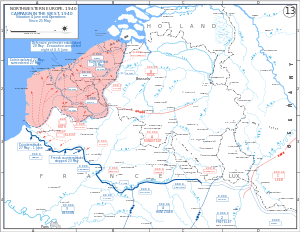Siege of Lille (1940)
| ||||||||||||||||||||||||||||
The Siege of Lille or Lille Pocket was a Second World War battle fought during the Battle of France. It took place from 28–31 May 1940 in the vicinity of Lille, France during the Battle of France. It involved the 40,000 men of the French IV Corps and V Corps of the First Army (General René Prioux), after the III Corps managed to retreat to the Lys river with the British Expeditionary Force (BEF) divisions nearby. The surrounded portion of the army fought seven German divisions, including three armoured divisions, that were attempting to cut off and destroy the Allied armies in the Battle of Dunkirk. The defence of Lille was of great assistance to the Allied troops retreating into the Dunkirk perimeter.
Prelude
On the night of 27/28 May, the BEF divisions near Lille were able to retreat over the Lys but only the III Corps of the French First Army (General René Prioux) managed to get away. Many of the French units had retreated from much further south and were still around Lille, when German units attacking from the west and east met behind the city.[2][lower-alpha 1] The 4th Panzer Division, 5th Panzer Division and 7th Panzer division and the 11th Infantry Division, 217th Infantry Division, 253rd Infantry Division and 267th infantry Division surrounded most of the First Army in Lille.[3]
Siege

The IV Corps (Général de corps d'armée Aymes) and V Corps (General René Altmeyer) attempted a breakout on the west side of Lille to retreat towards the Lys at 7:30 p.m. on 28 May. The 2e Division d'infanterie nord-africaine (2e DINA, Major-General Pierre Dame) tried to cross the Deûle river over the bridge to Sequedin (just south of Lomme). The 5e Division d'infanterie nord-africaine (5e DINA, Major-General Augustin Agliany) tried to escape over the Moulin Rouge bridge on the Santes road, south of Haubourdin.[4]
Another attempt was made during the morning of 29 May. The Germans had mined the bridge but two French tanks and two companies of infantry got across and were then repulsed.[4] For the next four days, General Molinié and mainly French North African troops (most of them pieds-noirs) fought on. Molinié and Colonel Aizier negotiated a surrender at midnight on 3/4 June; on Saturday, 1 June, French troops and some British surrendered arms to the Germans at the Grand Place. In honour of the defenders of Lille and its suburbs, 35,000 men of the garrison was allowed to march into captivity. As a consequence of the French defence of Lille, the BEF and the rest of the First Army were able to retreat into the Dunkirk perimeter.[5]
Analysis
Aftermath
In his celebrated book The Second World War (1949), Winston Churchill described the Allied defence of Lille as a "splendid contribution" which delayed the German advance for four days and allowed the escape of the British Expeditionary Force from Dunkirk.[6]
William L. Shirer wrote in 1969 that the "gallant" defence of Lille "helped the beleaguered Anglo-French forces around the port to hold out for an additional two to three days and thus save at least 100,000 more troops".[1]
Notes
- ↑ Units involved, French: 15th Infantry Division, 1st Motorized Division, 2nd North African Division, 1st Moroccan Division, German: 4th Panzer Division, 5th Panzer Division, 7th Panzer Division, 7th Division, 253rd Division, 217th Division, 267th Division.
Footnotes
- 1 2 3 Shirer 1969, p. 746.
- ↑ Ellis 2004, p. 191.
- ↑ Ellis 2004, Map, 214–215.
- 1 2 Sebag-Montefiore 2006, p. 624.
- ↑ Horne 1982, p. 604.
- ↑ Churchill 1949, p. 94.
References
- Churchill, W. S. (1949). Their Finest Hour. The Second World War. II. Boston, Mass: Mariner Books. ISBN 0-395-41056-8.
- Ellis, Major L. F. (2004) [1st. pub. HMSO 1954]. Butler, J. R. M., ed. The War in France and Flanders 1939–1940. History of the Second World War United Kingdom Military Series. Naval & Military Press. ISBN 978-1-84574-056-6. Retrieved 1 September 2015.
- Horne, A. (1982) [1969]. To Lose a Battle: France 1940 (Penguin repr. ed.). London: Macmillan. ISBN 0-14-00-5042-6.
- Sebag-Montefiore, H. (2006). Dunkirk: Fight to the Last Man. London: Penguin. ISBN 0141024372.
- Shirer, William (1969). The Collapse of the Third Republic: An Inquiry into the Fall of France in 1940. New York: Simon & Schuster. ISBN 978-0-671-20337-5.
Further reading
- Bond, Brian (1990). Britain, France and Belgium 1939–1940 (2nd ed.). London: Brassey's Publishing. ISBN 0-08-037700-9.
- Bond, B.; Taylor, M. D., eds. (2001). The Battle for France & Flanders Sixty Years On. Barnsley: Leo Cooper. ISBN 0-85052-811-9.
- Cooper, M. (1978). The German Army 1933–1945, its Political and Military Failure. Briarcliff Manor, NY: Stein and Day. ISBN 0-8128-2468-7.
- Corum, James (1997). The Luftwaffe: Creating the Operational Air War, 1918–1940. Lawrence: University Press of Kansas. ISBN 978-0-7006-0836-2.
- Cull, B.; Lander, Bruce; Weiss, Heinrich (2001). Twelve Days: The Air Battle for Northern France and the Low Countries, 10–21 May 1940, As Seen Through the Eyes of the Fighter Pilots Involved. London: Grub Street. ISBN 978-1-902304-12-0.
- Frieser, K-H. (2005). The Blitzkrieg Legend (English trans. ed.). Annapolis, MD: Naval Institute Press. ISBN 1-59114-294-6.
- Guderian, Heinz. Panzer Leader (2001 ed.). New York: Da Capo Press. ISBN 978-0306811012.
- Harman, Nicholas (1980). Dunkirk: The Necessary Myth. London: Hodder and Stoughton. ISBN 0-340-24299-X.
- Marix Evans, Martin (2000). The Fall of France: Act with Daring. Oxford: Osprey. ISBN 1-85532-969-7.
- Taylor, A. J. P.; Mayer, S. L., eds. (1974). A History Of World War Two. London: Octopus Books. ISBN 0-7064-0399-1.
Coordinates: 50°38′0″N 3°4′0″E / 50.63333°N 3.06667°E

